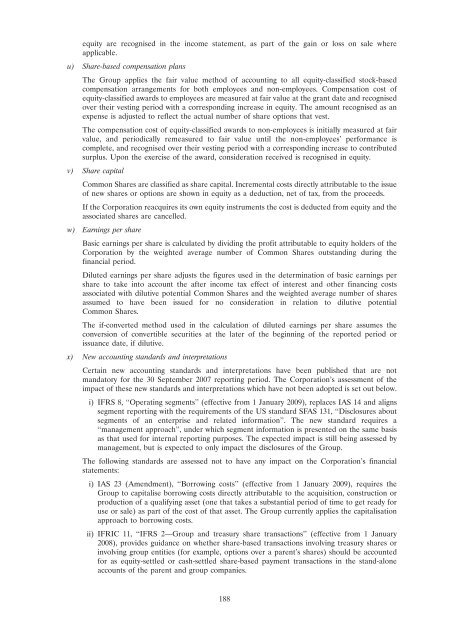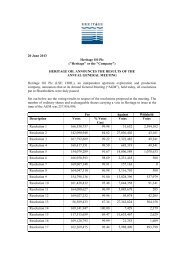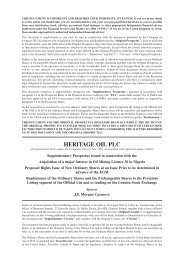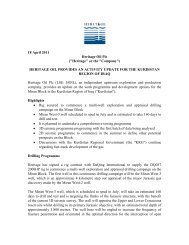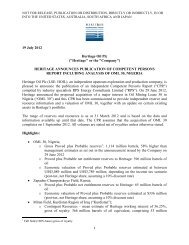Prospectus re Admission to the Official List - Heritage Oil
Prospectus re Admission to the Official List - Heritage Oil
Prospectus re Admission to the Official List - Heritage Oil
Create successful ePaper yourself
Turn your PDF publications into a flip-book with our unique Google optimized e-Paper software.
equity a<strong>re</strong> <strong>re</strong>cognised in <strong>the</strong> income statement, as part of <strong>the</strong> gain or loss on sale whe<strong>re</strong>applicable.u) Sha<strong>re</strong>-based compensation plansThe Group applies <strong>the</strong> fair value method of accounting <strong>to</strong> all equity-classified s<strong>to</strong>ck-basedcompensation arrangements for both employees and non-employees. Compensation cost ofequity-classified awards <strong>to</strong> employees a<strong>re</strong> measu<strong>re</strong>d at fair value at <strong>the</strong> grant date and <strong>re</strong>cognisedover <strong>the</strong>ir vesting period with a cor<strong>re</strong>sponding inc<strong>re</strong>ase in equity. The amount <strong>re</strong>cognised as anexpense is adjusted <strong>to</strong> <strong>re</strong>flect <strong>the</strong> actual number of sha<strong>re</strong> options that vest.The compensation cost of equity-classified awards <strong>to</strong> non-employees is initially measu<strong>re</strong>d at fairvalue, and periodically <strong>re</strong>measu<strong>re</strong>d <strong>to</strong> fair value until <strong>the</strong> non-employees’ performance iscomplete, and <strong>re</strong>cognised over <strong>the</strong>ir vesting period with a cor<strong>re</strong>sponding inc<strong>re</strong>ase <strong>to</strong> contributedsurplus. Upon <strong>the</strong> exercise of <strong>the</strong> award, consideration <strong>re</strong>ceived is <strong>re</strong>cognised in equity.v) Sha<strong>re</strong> capitalCommon Sha<strong>re</strong>s a<strong>re</strong> classified as sha<strong>re</strong> capital. Inc<strong>re</strong>mental costs di<strong>re</strong>ctly attributable <strong>to</strong> <strong>the</strong> issueof new sha<strong>re</strong>s or options a<strong>re</strong> shown in equity as a deduction, net of tax, from <strong>the</strong> proceeds.If <strong>the</strong> Corporation <strong>re</strong>acqui<strong>re</strong>s its own equity instruments <strong>the</strong> cost is deducted from equity and <strong>the</strong>associated sha<strong>re</strong>s a<strong>re</strong> cancelled.w) Earnings per sha<strong>re</strong>Basic earnings per sha<strong>re</strong> is calculated by dividing <strong>the</strong> profit attributable <strong>to</strong> equity holders of <strong>the</strong>Corporation by <strong>the</strong> weighted average number of Common Sha<strong>re</strong>s outstanding during <strong>the</strong>financial period.Diluted earnings per sha<strong>re</strong> adjusts <strong>the</strong> figu<strong>re</strong>s used in <strong>the</strong> determination of basic earnings persha<strong>re</strong> <strong>to</strong> take in<strong>to</strong> account <strong>the</strong> after income tax effect of inte<strong>re</strong>st and o<strong>the</strong>r financing costsassociated with dilutive potential Common Sha<strong>re</strong>s and <strong>the</strong> weighted average number of sha<strong>re</strong>sassumed <strong>to</strong> have been issued for no consideration in <strong>re</strong>lation <strong>to</strong> dilutive potentialCommon Sha<strong>re</strong>s.The if-converted method used in <strong>the</strong> calculation of diluted earnings per sha<strong>re</strong> assumes <strong>the</strong>conversion of convertible securities at <strong>the</strong> later of <strong>the</strong> beginning of <strong>the</strong> <strong>re</strong>ported period orissuance date, if dilutive.x) New accounting standards and interp<strong>re</strong>tationsCertain new accounting standards and interp<strong>re</strong>tations have been published that a<strong>re</strong> notmanda<strong>to</strong>ry for <strong>the</strong> 30 September 2007 <strong>re</strong>porting period. The Corporation’s assessment of <strong>the</strong>impact of <strong>the</strong>se new standards and interp<strong>re</strong>tations which have not been adopted is set out below.i) IFRS 8, ‘‘Operating segments’’ (effective from 1 January 2009), <strong>re</strong>places IAS 14 and alignssegment <strong>re</strong>porting with <strong>the</strong> <strong>re</strong>qui<strong>re</strong>ments of <strong>the</strong> US standard SFAS 131, ‘‘Disclosu<strong>re</strong>s aboutsegments of an enterprise and <strong>re</strong>lated information’’. The new standard <strong>re</strong>qui<strong>re</strong>s a‘‘management approach’’, under which segment information is p<strong>re</strong>sented on <strong>the</strong> same basisas that used for internal <strong>re</strong>porting purposes. The expected impact is still being assessed bymanagement, but is expected <strong>to</strong> only impact <strong>the</strong> disclosu<strong>re</strong>s of <strong>the</strong> Group.The following standards a<strong>re</strong> assessed not <strong>to</strong> have any impact on <strong>the</strong> Corporation’s financialstatements:i) IAS 23 (Amendment), ‘‘Borrowing costs’’ (effective from 1 January 2009), <strong>re</strong>qui<strong>re</strong>s <strong>the</strong>Group <strong>to</strong> capitalise borrowing costs di<strong>re</strong>ctly attributable <strong>to</strong> <strong>the</strong> acquisition, construction orproduction of a qualifying asset (one that takes a substantial period of time <strong>to</strong> get <strong>re</strong>ady foruse or sale) as part of <strong>the</strong> cost of that asset. The Group cur<strong>re</strong>ntly applies <strong>the</strong> capitalisationapproach <strong>to</strong> borrowing costs.ii) IFRIC 11, ‘‘IFRS 2—Group and t<strong>re</strong>asury sha<strong>re</strong> transactions’’ (effective from 1 January2008), provides guidance on whe<strong>the</strong>r sha<strong>re</strong>-based transactions involving t<strong>re</strong>asury sha<strong>re</strong>s orinvolving group entities (for example, options over a pa<strong>re</strong>nt’s sha<strong>re</strong>s) should be accountedfor as equity-settled or cash-settled sha<strong>re</strong>-based payment transactions in <strong>the</strong> stand-aloneaccounts of <strong>the</strong> pa<strong>re</strong>nt and group companies.188


